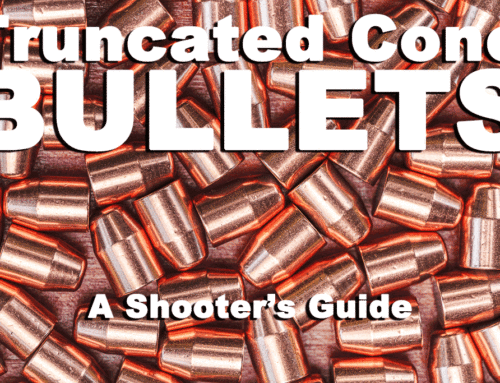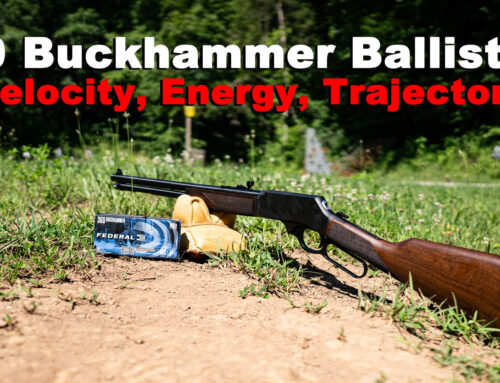If you’re looking for ammo to use for conceal carry or self-defense, jacketed hollow point is your answer. These rounds are loaded with a bullet that’s designed to expand when it makes contact with a target. This causes a larger wound channel that full metal jacket ammo and potentially doing more to neutralize a threat.
What is a Hollow Point?
The hollow point’s name is straightforward. In the bullet’s nose you will see a cavity, or a hollow, if you will. It’s almost as though it has been scooped out. The HP doesn’t maintain its original shape as it burrows through a soft target, like a full metal jacket or hard cast bullet would. Instead, the hollow point’s nose cavity enables it to open up, or “mushroom,” during penetration.
Why Use A Hollow Point?

A Speer Gold Dot bullet fired into ballistic gelatin. Notice how the bullet opened up or “mushroomed” inside the gel.
There are two major benefits to such terminal performance. First, the bullet will create a wider wound channel that has a greater likelihood of overlapping with a vital organ to quickly debilitate a threat. Second, by widening so quickly the bullet increases drag and slows down. This means it’s more likely to stop inside your target and poses less risk of overpenetrating through that target. When the bullet stops in the target, bystanders are in less danger. In a home-defense situation, this is an obvious concern for self-defense shooters.
There is an entire sub-culture of shooters dedicated to the study of self-defense ammo. From backyard experiments to Federal Bureau of Investigation trials, self-defense rounds are a complicated issue.
Hollow Points vs. Jacketed Hollow Points
Jackets wrap and surround many hollow point bullets. A jacketed hollow point benefits performance by promoting smoother feeding in a semi-automatic weapon, reducing the rate at which the bore fouls, facilitating penetration of the target, and controlling expansion so that it occurs in a reliable fashion.
Many jacketed hollow point bullets have notches around their tips, which create preexisting fault lines that work even further to ensure expansion takes place along a set course. Most modern self-defense ammunition features jacketed hollow point projectiles.
Potential Downsides to Using JHP Ammo

Barnes jacketed hollow point ammunition for pistols chambered in 380 ACP.
There are some caveats to consider before you count on a hollow point bullet. By nature of its design, the bullet’s nose cavity can become clogged with detritus such as thick fabric as it strikes its target, thus impacting its ability to expand to its fullest potential. Some hollow point bullets possess a feature to help prevent that from happening. For example, Speer fills their Gold Dot G2’s nose cavitywith soft elastomer, and Federal’s Hydra-Shok possesses a small center post.
Need Penetration Instead of Expansion? Look Elsewhere!
There are some instances where penetration is of greater importance than expansion. For instance, defense against armored targets or hunting very large game. In these cases, we generally don’t suggest you fire a hollow point. Another important factor to bear in mind is that the hollow point’s profile is generally not as conducive to smooth feeding in a semi-automatic weapon as a round nose bullet’s would be.
JHPs for Hunting
The hollow point’s utility is not limited to self-defense. The bullet’s tendency to create a wide wound channel is also valuable for hunting — what would neutralize a human-sized target is certainly able to kill small to medium-sized game.
Barnes makes their TSX bullet entirely of copper. It’s a hunting bullet equipped with a nose cavity. That cavity enables rapid and deadly expansion during penetration. (You can find this TSX bullet loaded into ammo by Black Hills.) Also, Hornady’s XTP is effective for whitetail if it’s of a large enough caliber. Shooters and hunters may favor certain hollow point bullets for their greater accuracy.
Sierra’s MatchKing features a narrow hollow point tip that markedly improves its ballistic coefficient. The open tip match bullet has an aperture that enabled its manufacturer to pour its core into place while still molten, making its weight exceptionally uniformly distributed. As a rule of thumb, a hollow point bullet optimized solely for accuracy won’t provide expanding terminal performance. At least not at a level you or I would consider ideal for personal protection or hunting.
Alternatives to Hollow Points
We should note the hollow point is not the only bullet that is capable of creating a wide, devastating wound channel during penetration. Some more modern bullets, such as Lehigh Defense’s Xtreme Penetrator and Inceptor Ammunition’s ARX, do not expand at all as they penetrate. These bullets resemble drill bits, and their grooves utilize lateral force dispersion to cause massive cavitation within their targets. These bullets’ profiles are more conducive to smooth feeding in a magazine fed weapon, although you will pay more for the advantage. A soft point bullet also widens as it penetrates, although generally not so much as a hollow point could.
Hollow point bullets are nearly universally more expensive than their full metal jacketed counterparts. This expense is why shooters train with them less frequently. Still, if you’re going to be as effective as you are capable of in a self-defense scenario, we suggest you at the very least try out any cartridge that you might one day stake your safety on.
Several manufacturers specialize in hollow point ammunition you can both affordably train with and reasonably depend upon. Do your research on the wide variety of hollow point ammunition that is available. From there, see what you like, and take some amusement that you’re buying something which you hope you will never need!





Leave A Comment